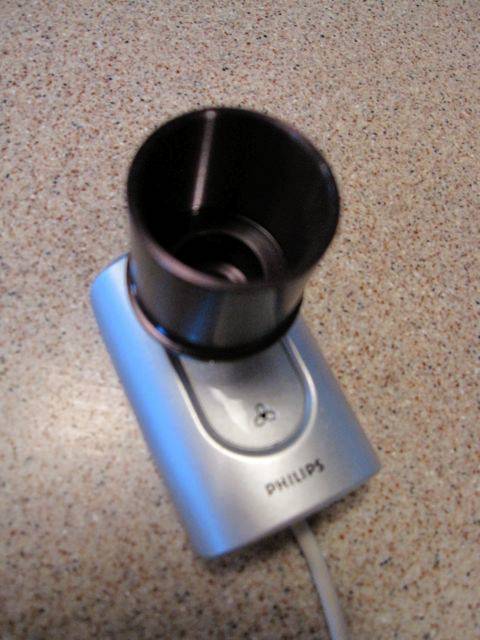

The Philips Toucam Pro (Philips Documentation) is basically a web cam, but has been used for planetary imaging, as it can provide high speed (60fps), relativey high resolution (1280x960) images, and has a 1.25" telescope eyepiece barrel for mounting into any scope. I have not yet used this camera - one of my "to do" items is to begin learning about planetary imaging ... but as of yet, I have only used my SBIG cameras for single-shot images of Jupiter, Saturn, Neptune and, of course, the moon. As with planetary imaging, lunar imaging uses 1) long focal length opticcal systems, 2) fast frame-rate CCD cameras (e.g., web cam), 3) good seeing and conditions to start with, taking a large number of frames (tens of thousands can be taken in tens of minutes), and 5) stacking programs that automatically sort the images to create a composite of only the sharpest images (such as the top 5% of the images). I have the PCVC840K model, which has the specifications shown below:
There is a screw-in 1.25" nosepiece that fits in place of the Toucam lens, enabling the camera to be put into a standard telescope (typically into the focuser, which may require a 2" to 1.25" adapter). The hookup to the computer is USB. I have not yet investigated which software is best used for planetary imaging, so am at a very early stage of learning about web cam imaging. I hope to do some planetary imaging in the near future. Planetary imaging first requires that the images are expanded - typically via either eyepiece projection, or using a barlow (or Televue Powermate) to increase the effective f#, and thus magnification of the image. Once the image is expanded, a relatively low resolution camera can provide images that are higher resolution than obtainable using a conventional (e.g., SBIG) CCD astronomical camera (without the Barlow). High speed imaging is done to try to capture some frames in-between atmospheric disturbances. Said another way, the goal is to image quickly enough that there are some times when the atmospheric column that the image must pass through is relatively stationary (compared to the scope aperture diameter). For example, if the wind speed is 10 mph (approx. 14.6 ft/sec, or about 450 cm/sec), and the scope is 12" in diameter (30 cm), then an exposure of less than 0.067 sec (67 milliseconds) would be required to "stop" the column of air moving past the scope. (of course, wind speeds in the jetstream can be much faster, requiring even shorter exposure times) The typical approach used these days for planetary imaging is to pick a clear night, focus carefully, and then take (for example) 20 minutes of high-speed video. This will produce (at 60fps) 72,000 frames of the planet - most of which will be "blurry" due to atmospheric distortions. However, some of the frames may catch a brief period of steady "seeing", and these can then be selected and stacked (in a program such as Registar) to produce incredible quality planetary images, such as those by Rolando Chavez, Brad Hill, and Jim Philips reproduced below with full credit to these great planetary astro-imagers: |
(one of several APOD shots of Jupiter by Rolando Chavez) |
(Brad Hill's APOD shot of Jupiter) |
(Jim Phillips' APOD shot of Jupiter with its moon, Callisto)
|
Philips Toucam Pro webcam for planetary astrophography with 1.25" eyepiece telescope adapter